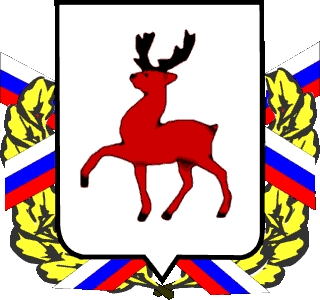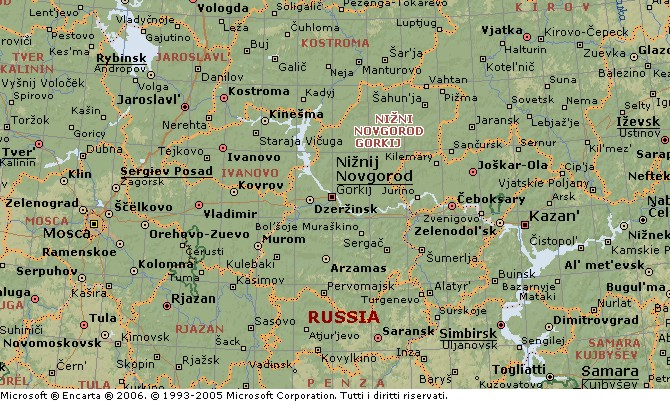Lessico
Niznij Novgorod
Gorkij ![]() dal 1932 al 1991
dal 1932 al 1991


Città con 1.438.000 abitanti della Russia, capoluogo della provincia omonima, 420 km a ENE di Mosca, alla confluenza dell'Oka nel Volga. La città alta, dominata dal Cremlino, è situata su tre colline che sorgono sulla destra del Volga, mentre la città bassa si estende sulle rive dei due fiumi.
Importante nodo di comunicazioni fluviali (al centro del grande sistema di vie d'acque interne detto “dei cinque mari”), stradali e ferroviarie, la città ha una rilevante funzione commerciale, ma tuttavia tende sempre più a basare la propria economia sull'industria che, favorita dalla vicinanza del grande bacino idroelettrico sul Volga e dalla costruzione di un oleodotto e di un gasdotto che collegano Niznij Novgorod ai giacimenti di Almetjevsk, è attiva nei settori siderurgico, meccanico, automobilistico, chimico, petrolchimico (Kstovo), tessile, delle materie plastiche, elettrotecnico, alimentare, della concia, della carta, del vetro e della gomma. Niznij Novgorod è inoltre un noto centro artistico e culturale, con un'università fondata nel 1918, e numerosi istituti superiori.
Fondata
nel 1221 da Jurij Vsevolodovic granduca di Vladimir, fu prima fortezza contro
le scorrerie dei Mordvini, poi mercato famoso. Nel 1417 fu incorporata allo
Stato moscovita. Ottimamente fortificata, respinse più volte gli assalti dei
Mongoli (sec. XVI). Dal 1524 fino al 1930 ebbe luogo nei suoi dintorni una
fiera, centro importantissimo di attrazione commerciale. Ebbe, dal 1932, il
nome di Gorkij in onore dello scrittore Maksim Gorkij![]() ,
ritornando all'originaria denominazione nel 1991.
,
ritornando all'originaria denominazione nel 1991.
La provincia di Niznij Novgorod (74.800 km2; 3.713.000 ab.) si estende su una regione pianeggiante attraversata dal fiume Volga e dai suoi tributari Oka, Vetluga, Sura e Pjana. Il territorio è ricoperto di foreste a nord, dove è fiorente l'industria cartaria, ed è coltivato a cereali nel settore sud-orientale; la sezione sud-occidentale è sede di numerose industrie che operano nei settori chimico (Dzerzinsk, Niznij Novgorod), metallurgico (Kulebaki, Vyksa), alimentare (Pavlovo), tessile (Arzamas), petrolchimico (Kstovo), meccanico (Niznij Novgorod, Dzerzinsk) e conciario (Bogorodsk). Centri importanti, oltre al capoluogo, sono Dzerzinsk, Arzamas, Pavlovo e Bor. Nella parte inferiore destra della cartina è localizzabile la città di Togliatti.
Togliatti
Stavropol fino al 1964
Città (630.000 ab.) della Russia, nella prov. di Samara, 60 km a NW del capoluogo, a 370 m sul Bacino di Samara del fiume Volga. Sorta nei pressi di una grande diga sul Volga, è un attivo porto fluviale con industrie chimiche, meccaniche (automobilistiche), cantieristiche, del cemento, del legno, delle materie plastiche e della gomma. Si chiamò Stavropol fino al 1964, quando morì il leader del Partito Comunista Italiano Palmiro Togliatti (Genova 1893-Jalta 1964), al quale deve il suo nuovo nome. In russo, Toljatti.
Dopo avergli indicato la presenza della città di Togliatti nella cartina, il Dr Romanov si è lasciato andare a questi ricordi personali: "I did not know Palmiro Togliatti in person. He died at a different place (in the Crimea) when I was 2 years old. No chance to meet him. Of course, he was a famous Italian communist in the Soviet times, so famous that Stavropol in Samara Region (note that there is another Stavropol in Northern Caucasus!) was renamed to Togliatti, the city of the Volga Automobile Plant (VAZ), that was built there in 1967-1971 as a collaboration between Italy and the Soviet Union. The plant produced the car model VAZ-2101 on the basis of FIAT 124 (another Italian link!) and other VAZ models." (e-mail del 22 settembre 2006)
Nizhny
Novgorod, colloquially shortened as Nizhny and also transliterated into
English as Nizhniy Novgorod or Nizhni Novgorod or Nizhnii Novgorod, is the
fourth largest city of Russia, ranking after Moscow, St. Petersburg, and
Novosibirsk. Population: 1,311,252 (2002 Census). It is the economic and
cultural center of the vast Volga-Vyatka economic region, and also the
administrative center of Nizhny Novgorod Oblast and Volga Federal District. From 1932
to 1990 the city was known as Gorky after the writer Maxim Gorky![]() .
.
The city was founded by Grand Duke George II of Russia in 1221 at the confluence of two most important rivers of his principality, the Volga and the Oka. Its name literally means Newtown the Lower, to distinguish it from the older Novgorod. A major stronghold for border protection, Nizhny Novgorod fortress took advantage of a natural moat formed by the two rivers.
Along with Moscow and Tver, Nizhny Novgorod was among several newly-founded towns that escaped Mongol devastation on account of their insignificance and grew up into great centers of Russian political life during the period of Tatar yoke. Its importance further increased, when the seat of the powerful Suzdal Principality was moved here from Gorodets in 1350. Grand Duke Dmitry Konstantinovich (1323-1383) sought to make his capital a rival worthy of Moscow: he built a stone citadel and several churches and was a patron of historians. The earliest extant manuscript of the Russian Primary Chronicle, the Laurentian Codex, was written for him by the local monk Laurentius in 1377.
After the city's incorporation into Muscovy (1392), the local princes took the name Shuisky and settled in Moscow, where they were prominent at the court and briefly ascended the throne in the person of Vasili IV. Nizhny Novgorod was regarded by the Muscovites primarily as a great stronghold in their wars against the Tatars of Kazan. The enormous red-brick kremlin, one of the strongest and earliest preserved citadels in Russia, was built in 1508–1511 under supervision of Peter the Italian. The fortress was strong enough to withstand Tatar sieges in 1520 and 1536.
In 1612, the so-called national militia, gathered by a local merchant Kuzma Minin and commanded by Knyaz Dmitry Pozharsky expelled the Polish troops from Moscow, thus putting an end to the Time of Troubles and establishing the rule of the Romanov dynasty. The main square before the kremlin is named after Minin, and his remains are buried in the citadel. Also in commemoration of these events on October 21, 2005 an exact copy of Red Square statue of Minin and Pozharsky was placed in front of St John the Baptist Church, which is believed to be the place from where the call to the people had been proclaimed.
In the course of the following century, the city prospered commercially and was chosen by the Stroganovs (the wealthiest merchant family of Russia) as a base for their operations. A particular style of architecture and icon painting, known as the Stroganov style, developed there at the turn of the 17th and 18th centuries.
The historical coat of arms of Nizhny Novgorod in 1781 was: In a white field a red deer, horns and hoofs are black. The modern coat of arms circa 1992 is the same but the shield can be adorned with golden oak leaves tied with a stripe with colors of Russian national flag.
In 1817, the Makariev fair, one of the liveliest in the world, was transferred to Nizhny Novgorod, which thereupon started to attract millions of visitors annually. By the mid-19th century, the city on the Volga was firmly established as the trade capital of the Russian Empire. The world’s first radio receiver of engineer Alexander Popov and the world’s first hyperboloid tower and lattice shells-coverings of engineer Vladimir Shukhov were demonstrated at the All-Russia industrial and art exhibition in Nizhny Novgorod in 1896. Other industries gradually developed, and by the dawn of the 20th century it was a first-rank industrial hub as well. Henry Ford helped build a large truck and tractor plant in the late 1920s, sending along engineers and mechanics, including future labor leader Walter Reuther.
Famous writer Maxim Gorky was born there in 1868, in his novels he realistically described the dismal life of the city proletariat. Even during his lifetime, the city was renamed Gorky following his return to the USSR from immigration in 1932 on invitation of Joseph Stalin. The city bore his name until 1991. During that time, the city was closed to foreigners to safeguard the security of Soviet military research. The physicist and the Nobel laureate Andrei Sakharov was exiled there until 1986 to limit his contacts with foreigners. An end to the "closed" status of the city has accompanied the reinstatement of the city's original name.
The modern city has a subway system, an airport, numerous theatres, institutes, and museums. Its modern industries are too numerous and diversified to mention; they include the production of GAZ lorries and Volga cars.
Much of the city downtown is built in the Russian Revival and Stalin Empire styles. The dominating feature of the city skyline is the grand kremlin (1500-11), with its red-brick towers. After Bolshevik devastation, the only ancient edifice left within the kremlin walls is the tent-like Archangel Cathedral (1624-31), first built in stone in the 13th century.
Other notable landmarks are the two great medieval abbeys. The Monastery of the Caves features the austere five-domed cathedral (1632) and two rare churches surmounted by tent roofs, dating from the 1640s. The Annunciation monastery, likewise surrounded by strong walls, has another five-domed cathedral (1649) and the Assumption church (1678). The only private house preserved from that epoch formerly belonged to the merchant Pushnikov.
There can be little doubt that the most original and delightful churches in the city were built by the Stroganovs in the nascent Baroque style. Of these, the Virgin's Nativity Church (1719) graces one of the central streets, whereas the Church of Our Lady of Smolensk (1694-97) survives in the suburb of Gordeevka, where the Stroganov palace once stood.
Other
notable churches include:
- the Saviour Cathedral, a huge domed edifice built at the site of the great
fair to an Empire style design by Agustin de Bétancourt and Auguste de
Montferrand in 1822;
- the so-called New Fair Cathedral, designed in the Russian Revival style and
constructed between 1856 and 1880 at the confluence of the Oka and the Volga;
- the recently reconstructed church of the Nativity of John the Precursor
(1676-83), standing just below - the kremlin walls; it was used during the
Soviet period as an apartment house;
- the parish churches of the Holy Wives (1649) and of Saint Elijah (1656);
- the Assumption Church on St Elijah's Hill (1672), with five green-tiled
domes arranged unorthodoxly on the lofty cross-shaped barrel roof;
- the shrine of the Old Believers at the Bugrovskoe cemetery, erected in the
1910s to a critically acclaimed design by Vladimir Pokrovsky;
- the wooden chapel of the Intercession (1660), transported to Nizhny Novgorod
from a rural area.
The city has many industrial suburbs, such as Kstovo, Dzerzhinsk, and Bor. The town of Semyonov, to the north of Nizhny Novgorod, is known as a craft center for Khokhloma wood painting. Another suburb, Balakhna, is noted for its medieval architecture. A singular 128-metre-high open-work hyperboloid tower was built on the bank of the Oka by the eminent engineer and scientist Vladimir Shukhov in 1929.
The climate in the region is continental, and it is similar to the climate in Moscow, although colder in winter, which lasts from late November until late March with a permanent snow cover.
The city can be easily reached from the Russian capital by an overnight train, by car or by air. Since December 2002, a fast train has connected Nizhny Novgorod and Moscow in less than 5 hours. The expansion of highways in the region is 8,100 miles, of railroads - 750 miles, and of waterways – 500 miles. Nizhny Novgorod has regular air connection (Strigino Airport) with a dozen of Russian cities, and international Lufthansa flights to the city three times a week. In summer, tourists may travel to Nizhny Novgorod from Moscow and Saint Petersburg by passenger vessels.